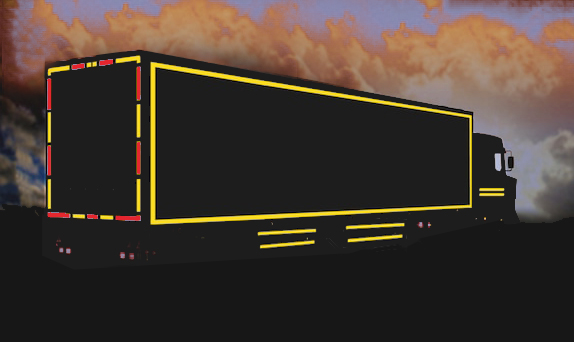Introduction
This article is a synopsis of a study conducted by the IATSS (International Association of Traffic and Safety Studies) The study, conducted in 2019, was structured to determine how reflective tape patterns and color affect vehicle visibility as it pertains to approaching drivers. Focus was given to rear end collisions, however, the study is also relevant to side impacts and their prevention. As with all reflective conspicuity treatments to vehicles, effectiveness as it pertains to collision reduction is always greatest at night.
Rear-end collisions involving heavy trucks represent a significant safety concern, particularly in developing countries with mixed traffic systems. These types of accidents, although not the most frequent, often result in severe injuries or fatalities. This is especially true of night time accidents. Limited visibility of heavy trucks, especially in low-light conditions, contributes significantly to these accidents. To address this issue, retro-reflective tape has been adopted as a cost-effective solution to improve truck visibility and reduce rear-end collisions. This article examines the effectiveness of various colors and patterns of retro-reflective tape and their impact on visibility, detection distance, perception-reaction time, and driver stress.
Methodology
The study undertaken by IATSS employed the Kitami Institute of Technology Driving Simulator (KITDS) to simulate various driving conditions and measure the effectiveness of different retro-reflective tape patterns. 9 basic patterns were studied. These include block patterns at the bottom area of the rear of a truck in different widths, block patterns that cover the perimeter of the rear of the truck, chevron panels in two color combinations, and a blank control pattern. Lime/Red and White/Red color combinations were used. Participants were exposed to different scenarios, including varying weather and lighting conditions, to evaluate how these factors influence detection distance and perception-reaction time. The study also utilized BACS Advance equipment to monitor heart rate and assess driver stress levels.
Three key experiments were conducted:
- Comparison of Retro-Reflective Tape Patterns:
- Objective: To evaluate the visibility of different tape patterns. 9 patterns in varying color combinations and widths.
- Participants: 19 volunteers (10 males, 9 females), aged 21-68.
- Method: Participants drove in the simulator and identified which truck (displaying different tape patterns) they recognized first.
- Detection Distance Measurement:
- Objective: To measure how far behind a truck a driver can detect the retro-reflective tape.
- Participants: 21 volunteers (12 males, 9 females), average age 29.
- Method: Participants drove at set speeds (60 km/h and 100 km/h) and noted when they first detected the reflective tape.
- Perception-Reaction Time and Heart Rate:
- Objective: To measure the time taken for drivers to react to seeing a truck and to monitor heart rate changes.
- Participants: 14 volunteers (6 males, 8 females), aged 21-69.
- Method: Participants drove at 80 km/h, and their reaction times and heart rates were recorded upon recognizing the tape.
Results and Discussion
Visibility Comparison of Retro-Reflective Tape Patterns
The study found that the most visible tape pattern was the fully outlined alternating red and yellow tape, conforming to UNECE Regulation No.48. This pattern outperformed others in terms of recognition frequency, indicating its superior visibility. The 10 cm wide tape was more effective than the 5 cm tape. Visibility rankings remained consistent across different participant ages, lighting, and weather conditions.
Detection Distance Analysis
Detection distance varied significantly with driver age, vehicle speed, tape width, and environmental conditions. The longest detection distances were recorded in adverse weather conditions (rainy and foggy), emphasizing the importance of effective retro-reflective tape in such scenarios. Middle-aged drivers showed better detection distances, likely due to a combination of developed perceptual abilities and driving experience. Female drivers generally detected the tape at greater distances than male drivers.
Perception-Reaction Time (PRT) and Heart Rate
PRT increased with driver age, with older drivers taking longer to react compared to younger and middle-aged drivers. Trucks with no retro-reflective tape resulted in significantly longer PRTs, highlighting the critical role of visibility enhancements. Heart rate measurements indicated higher stress levels (lower LF/HF ratios and RMSSD values) in older drivers, while middle-aged drivers exhibited better stress management likely due to greater driving experience.
Conclusions
The study conclusively demonstrates that the selection of retro-reflective tape pattern and color significantly impacts the visibility of heavy trucks, detection distance, and driver reaction times. The combination of red and yellow tape, applied horizontally and vertically on both the right and left, as well as the upper and lower sections of trucks, was found to be the most effective. The second most visible pattern and color combination was found to be the chevron pattern in lime and red at the bottom of the rear of a truck.
The study recommends that this configuration, as stipulated by UNECE Regulation No.48, should be adopted by countries to enhance truck visibility and reduce rear-end collisions. The study underscores the need for regulatory revisions in countries where current tape patterns may not be sufficiently visible.
Note – reflective tape performance in traffic is higher when it is place lower on the truck. This is due to the fact that car headlights may not strike tape place higher when the car is close in. So special attention should be given to marking the lower areas of the truck, with perimeter conspicuity being a very beneficial bonus to this basic treatment. Also, this same method of conspicuity can be used on the sides of a vehicle. A strip of red and lime placed low increase visibility substantially, especially at night. And a contour application using the same colors and pattern is even more effective.
